Road
Rail & Canal
|
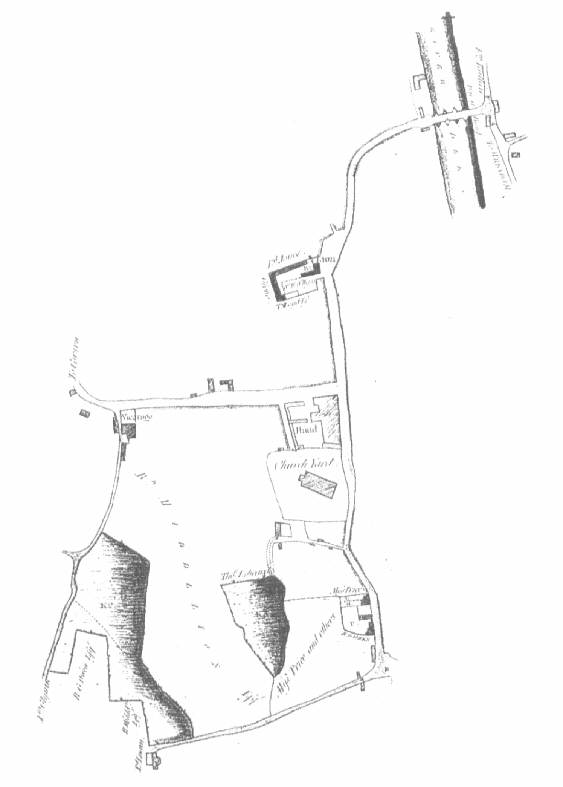 Roads Roads
Prior to the A5
construction, the main highway through Llangollen from the south was
via Church Street, Chapel Street and Hall Street and then on through
Berwyn en route to Ireland. Continuing down Bridge Street instead of
turning up Chapel Street would lead to Llangollen Mill and over the
Bridge to Llantysilio. Many of the oldest properties in Llangollen
are thus found on these streets. Telford’s A5, built in 1815 as
the main road from London to Holyhead, substantially reduced
travelling times and opened the way for tourism and commerce. Up
until the latter part of the 19th century the streets of the town
were simply hard packed earth with no drainage at the sides. They
were muddy in wet weather and dusty in dry weather as well as being
littered with the sewage thrown from the houses. At an inquiry held
in 1853 Mr. Charles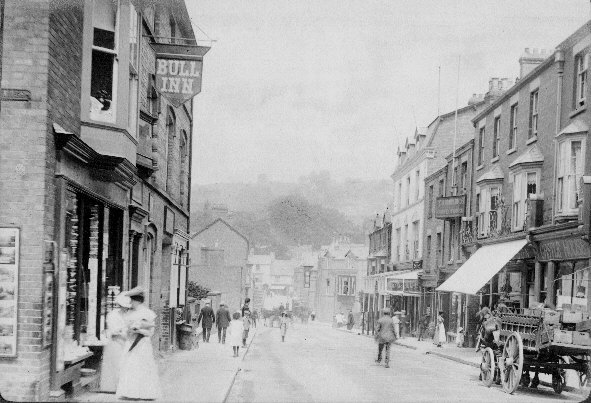 Richards commented that the highways throughout the parish were
badly kept. He suggested that the roads should be under one
management and that he should be a paid officer. However, in 1870, a
letter in the Llangollen advertiser still said 'A lady in a
long and big dress and high heeled boots would not be able to cross
the bridge or walk throu one of the streets without being rendered
unfit to enter a friends drawing room'. However, in 1874 there
are reports of boatloads of stone being brought from Trevor Rocks to
improve the streets in the town, so improvement was on its way.
Richards commented that the highways throughout the parish were
badly kept. He suggested that the roads should be under one
management and that he should be a paid officer. However, in 1870, a
letter in the Llangollen advertiser still said 'A lady in a
long and big dress and high heeled boots would not be able to cross
the bridge or walk throu one of the streets without being rendered
unfit to enter a friends drawing room'. However, in 1874 there
are reports of boatloads of stone being brought from Trevor Rocks to
improve the streets in the town, so improvement was on its way.
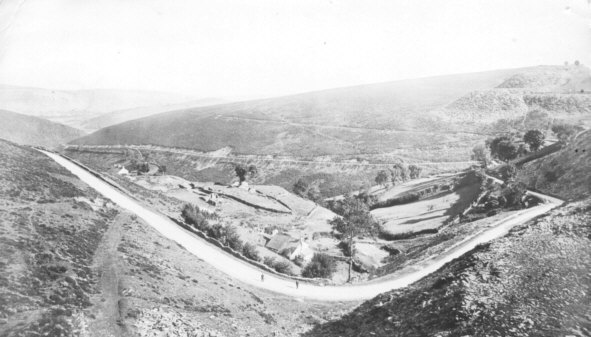 The routes running through
Llantysilio have also seen change over the years. In the past, many
of the routes were used by drovers leading their stock to market in
Llangollen. Before the building of the The routes running through
Llantysilio have also seen change over the years. In the past, many
of the routes were used by drovers leading their stock to market in
Llangollen. Before the building of the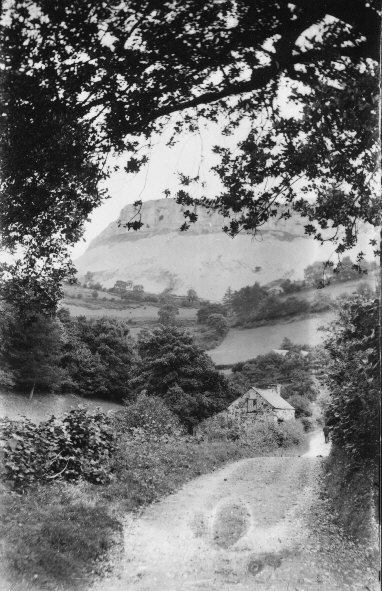 Horseshoe Pass in 1811, all
travellers heading north from Llangollen had to either travel
through Llantysilio and over the top of the mountains or up to
Pentredwr and up the old pass (Bwlch yr Oernant) Horseshoe Pass in 1811, all
travellers heading north from Llangollen had to either travel
through Llantysilio and over the top of the mountains or up to
Pentredwr and up the old pass (Bwlch yr Oernant)
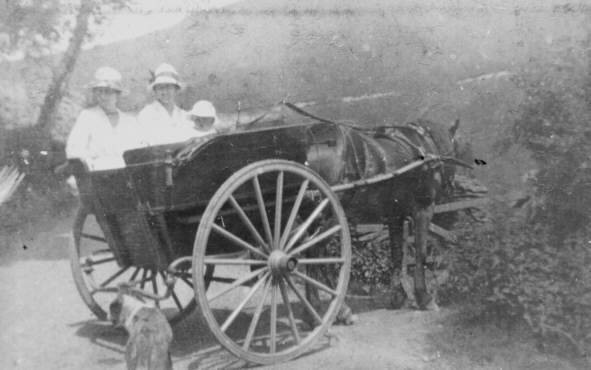
Smaller
roads in the countryside remained little more than dirt tracks until
well into the 20th century. Up until the 1930s many people still
used horse and cart for their daily transportation. |
| top of page |
|
The first passenger train
arrived at Llangollen in 1862 but at that time the station was
further down the road towards Wrexham (Mill Street) near where the
River’s Edge Hotel stands today. Before this, the nearest station
was Whitehurst Halt near Froncysyllte (locally known as Y Stesion Tŷ
Coch). At that time the major hotels ran a ‘taxi’ service from
the station to Llangollen and it was to this station that George
Borrow, the author of ‘Wild Wales’ arrived in 1854.
 There
was much argument over the route of the new railway with numerous
public meetings and letters of protest appearing in the local
newpapers during the 1850s. The chief engineer of the Llangollen
railway was Henry Robertson, a highly influential local man who also
owned a nearby ironworks and no doubt had much to gain. The work
took much longer than expected, despite the employment of huge
numbers of labourers, who even worked on Sundays, much to the
disgust of many people. To be fair they were also effected by a very
bad winter of 1860/61 which for a time brought all work to a halt.
The first goods train arrived in December 1861 and the first
passengers on 2nd June 1862. There
was much argument over the route of the new railway with numerous
public meetings and letters of protest appearing in the local
newpapers during the 1850s. The chief engineer of the Llangollen
railway was Henry Robertson, a highly influential local man who also
owned a nearby ironworks and no doubt had much to gain. The work
took much longer than expected, despite the employment of huge
numbers of labourers, who even worked on Sundays, much to the
disgust of many people. To be fair they were also effected by a very
bad winter of 1860/61 which for a time brought all work to a halt.
The first goods train arrived in December 1861 and the first
passengers on 2nd June 1862.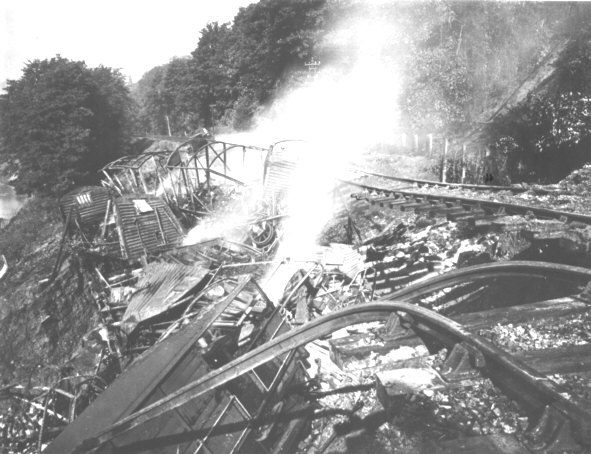
The present station at Llangollen
opened in 1865 when the line was extended to Corwen and later as far
as Dolgellau. Travelling to the coast at Barmouth became very
popular. When the railway was extended a new arch had to be built
through Llangollen bridge and at the same time a pub called The
Trevor Arms was knocked down. This stood were the telephone boxes
are today. The railway company later became part of the Great
Western Railway Company. 1n 1953 The Queen and Prince Philip arrived
in Llangollen by train as part of a tour of Wales. There are still
people in Llangollen who remember travelling from Llangollen to
London without changing! 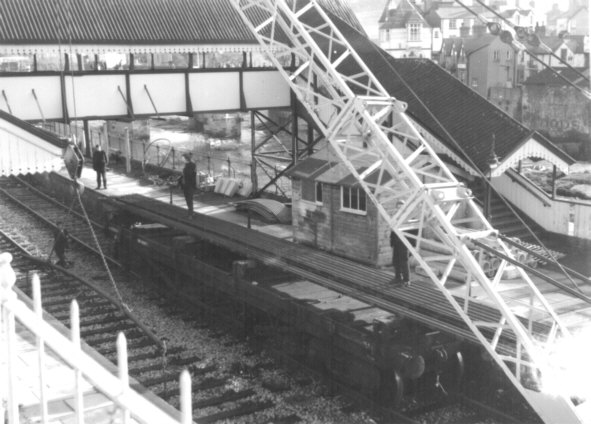 The
line and station closed in 1965 and for years it was left in a
terrible state, falling to ruins and full of weeds. The station and
the line as far as Carrog, to the west were re-opened by volunteers
in the 1970s and continues to operate as a major tourist attraction. The
line and station closed in 1965 and for years it was left in a
terrible state, falling to ruins and full of weeds. The station and
the line as far as Carrog, to the west were re-opened by volunteers
in the 1970s and continues to operate as a major tourist attraction.
|
| top of page |
|
In 1804 the Ellesmere Canal
Company obtained powers to construct a navigable feeder from the
River Dee at Llantysilio to the end of the Pontcysyllte Aqueduct,
then under construction. The Aqueduct was completed by Thomas
Telford in 1805 and remains one of the most impressive feats of
canal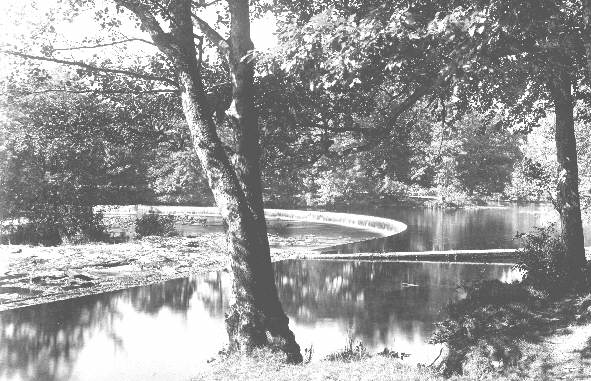 engineering in the world. The canal is carried in a cast iron trough
127 feet above the river on 18 stone piers. Telford completed the
top section of the Llangollen Canal in 1808 and at that time it
would have been very busy with goods such as salt and coal coming
into the town and slate going out. The Horseshoe Falls at the head
of the canal were built at this time to provide a minimum head of
water for the canal. In 1947 a valve house was constructed to
control and measure the 6 million gallons of water that flow into
the canal each day.
engineering in the world. The canal is carried in a cast iron trough
127 feet above the river on 18 stone piers. Telford completed the
top section of the Llangollen Canal in 1808 and at that time it
would have been very busy with goods such as salt and coal coming
into the town and slate going out. The Horseshoe Falls at the head
of the canal were built at this time to provide a minimum head of
water for the canal. In 1947 a valve house was constructed to
control and measure the 6 million gallons of water that flow into
the canal each day.
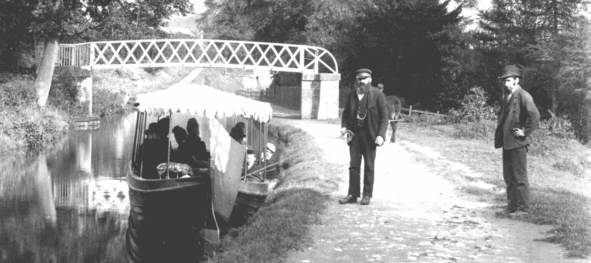 For
over 100 years people have enjoyed the calm relaxation of a
boat trip on the Llangollen Canal. The horse drawn tourist boats
were originated by the heavily bearded Captain Jones who ran trips
from Llangollen Wharf to the Horseshoe Falls several times a day. For
over 100 years people have enjoyed the calm relaxation of a
boat trip on the Llangollen Canal. The horse drawn tourist boats
were originated by the heavily bearded Captain Jones who ran trips
from Llangollen Wharf to the Horseshoe Falls several times a day.
top of page |
|
 Roads
Roads Richards commented that the highways throughout the parish were
badly kept. He suggested that the roads should be under one
management and that he should be a paid officer. However, in 1870, a
letter in the Llangollen advertiser still said 'A lady in a
long and big dress and high heeled boots would not be able to cross
the bridge or walk throu one of the streets without being rendered
unfit to enter a friends drawing room'. However, in 1874 there
are reports of boatloads of stone being brought from Trevor Rocks to
improve the streets in the town, so improvement was on its way.
Richards commented that the highways throughout the parish were
badly kept. He suggested that the roads should be under one
management and that he should be a paid officer. However, in 1870, a
letter in the Llangollen advertiser still said 'A lady in a
long and big dress and high heeled boots would not be able to cross
the bridge or walk throu one of the streets without being rendered
unfit to enter a friends drawing room'. However, in 1874 there
are reports of boatloads of stone being brought from Trevor Rocks to
improve the streets in the town, so improvement was on its way. The routes running through
Llantysilio have also seen change over the years. In the past, many
of the routes were used by drovers leading their stock to market in
Llangollen. Before the building of the
The routes running through
Llantysilio have also seen change over the years. In the past, many
of the routes were used by drovers leading their stock to market in
Llangollen. Before the building of the Horseshoe Pass in 1811, all
travellers heading north from Llangollen had to either travel
through Llantysilio and over the top of the mountains or up to
Pentredwr and up the old pass (Bwlch yr Oernant)
Horseshoe Pass in 1811, all
travellers heading north from Llangollen had to either travel
through Llantysilio and over the top of the mountains or up to
Pentredwr and up the old pass (Bwlch yr Oernant)
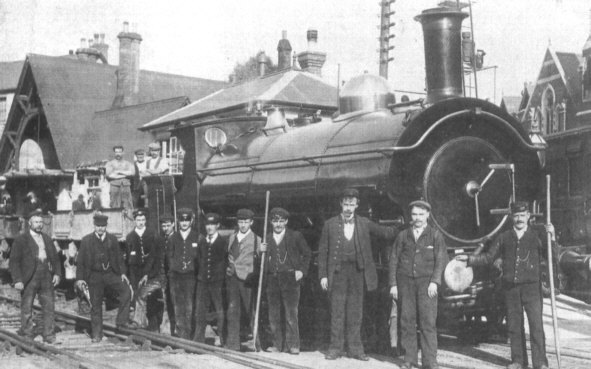
 There
was much argument over the route of the new railway with numerous
public meetings and letters of protest appearing in the local
newpapers during the 1850s. The chief engineer of the Llangollen
railway was Henry Robertson, a highly influential local man who also
owned a nearby ironworks and no doubt had much to gain. The work
took much longer than expected, despite the employment of huge
numbers of labourers, who even worked on Sundays, much to the
disgust of many people. To be fair they were also effected by a very
bad winter of 1860/61 which for a time brought all work to a halt.
The first goods train arrived in December 1861 and the first
passengers on 2nd June 1862.
There
was much argument over the route of the new railway with numerous
public meetings and letters of protest appearing in the local
newpapers during the 1850s. The chief engineer of the Llangollen
railway was Henry Robertson, a highly influential local man who also
owned a nearby ironworks and no doubt had much to gain. The work
took much longer than expected, despite the employment of huge
numbers of labourers, who even worked on Sundays, much to the
disgust of many people. To be fair they were also effected by a very
bad winter of 1860/61 which for a time brought all work to a halt.
The first goods train arrived in December 1861 and the first
passengers on 2nd June 1862.
 The
line and station closed in 1965 and for years it was left in a
terrible state, falling to ruins and full of weeds. The station and
the line as far as Carrog, to the west were re-opened by volunteers
in the 1970s and continues to operate as a major tourist attraction.
The
line and station closed in 1965 and for years it was left in a
terrible state, falling to ruins and full of weeds. The station and
the line as far as Carrog, to the west were re-opened by volunteers
in the 1970s and continues to operate as a major tourist attraction.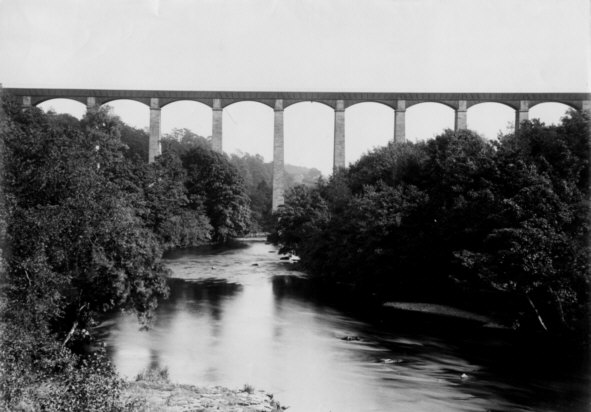
 engineering in the world. The canal is carried in a cast iron trough
127 feet above the river on 18 stone piers. Telford completed the
top section of the Llangollen Canal in 1808 and at that time it
would have been very busy with goods such as salt and coal coming
into the town and slate going out. The Horseshoe Falls at the head
of the canal were built at this time to provide a minimum head of
water for the canal. In 1947 a valve house was constructed to
control and measure the 6 million gallons of water that flow into
the canal each day.
engineering in the world. The canal is carried in a cast iron trough
127 feet above the river on 18 stone piers. Telford completed the
top section of the Llangollen Canal in 1808 and at that time it
would have been very busy with goods such as salt and coal coming
into the town and slate going out. The Horseshoe Falls at the head
of the canal were built at this time to provide a minimum head of
water for the canal. In 1947 a valve house was constructed to
control and measure the 6 million gallons of water that flow into
the canal each day. For
over 100 years people have enjoyed the calm relaxation of a
boat trip on the Llangollen Canal. The horse drawn tourist boats
were originated by the heavily bearded Captain Jones who ran trips
from Llangollen Wharf to the Horseshoe Falls several times a day.
For
over 100 years people have enjoyed the calm relaxation of a
boat trip on the Llangollen Canal. The horse drawn tourist boats
were originated by the heavily bearded Captain Jones who ran trips
from Llangollen Wharf to the Horseshoe Falls several times a day.